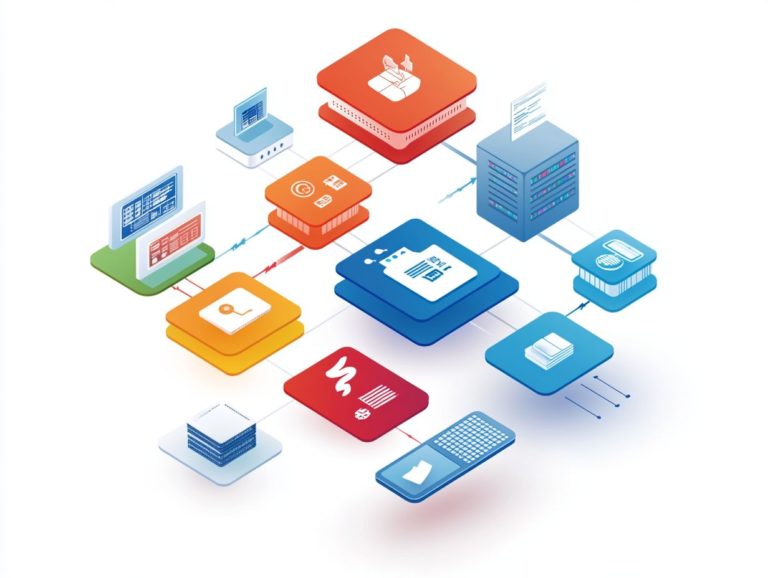How to Build a Cloud Business Case?
In today s fast-paced digital landscape, cloud computing is essential for businesses of all sizes.
This article delves into the core concepts and various service types of cloud computing, highlighting the significant advantages it offers, including cost savings and enhanced collaboration.
You ll also find a discussion on critical factors to consider when building a cloud business case, along with actionable steps to help you successfully implement a cloud strategy tailored to your organization s unique needs.
Discover how cloud technology can benefit your business!
Contents
- Key Takeaways:
- Understanding Cloud Computing
- Benefits of Cloud Computing for Businesses
- Factors to Consider When Building a Cloud Business Case
- Potential Risks and Mitigation Strategies
- ROI and Cost Analysis
- Steps to Building a Successful Cloud Business Case
- Identifying Business Objectives
- Researching and Selecting a Cloud Provider
- Frequently Asked Questions
- What is a cloud business case?
- Why is it important to build a cloud business case?
- What are the key elements of a cloud business case?
- How do you identify the potential benefits of cloud technology for a business?
- What are some potential challenges when building a cloud business case?
- What are some tips for presenting a cloud business case to stakeholders?
Key Takeaways:

Building a strong cloud business case starts with understanding your IT needs, identifying risks, and calculating return on investment. Cloud computing offers businesses cost savings, scalability, flexibility, and improved collaboration and accessibility. To build a successful cloud business case, create a cloud adoption plan that clearly identifies business objectives, researches and selects a reliable cloud provider, and develops a detailed implementation strategy.
Understanding Cloud Computing
Understanding cloud computing is crucial for your modern business if you aim to leverage technology for a competitive edge. It grants you access to IT resources via the internet, providing scalable solutions that can be tailored to your specific needs.
Major providers like AWS and Azure present a variety of models, such as:
- Software as a Service (SaaS)
- Infrastructure as a Service (IaaS)
- Platform as a Service (PaaS)
These models are designed to enhance your operational resilience and efficiency. By using applications designed specifically for the cloud, you position your organization to swiftly adapt to the fast-paced digital landscape, ensuring you remain ahead of the curve.
What is Cloud Computing?
Cloud computing is all about delivering computing services over the internet, offering you flexibility, scalability, and the ability to use resources whenever you need them.
This groundbreaking technology includes a range of services, such as storage solutions, processing power, and application hosting, all within reach through a web browser or dedicated software. You can choose from various delivery models tailored to your specific needs, including:
- Infrastructure as a Service (IaaS)
- Platform as a Service (PaaS)
- Software as a Service (SaaS)
Each model is designed with your unique requirements in mind. Cloud environments can be deployed in several ways public, private, or hybrid based on your organization’s needs and its security considerations.
Whether enabling remote work or powering intricate machine learning algorithms, the applications of cloud computing are extensive, underscoring its crucial role in today s digital landscape.
Types of Cloud Services
You ll find three primary types of cloud services: Infrastructure as a Service (IaaS), Platform as a Service (PaaS), and Software as a Service (SaaS). Each offers varying degrees of control and management tailored to your specific needs.
With IaaS, you can rent virtualized hardware resources like servers and storage, giving you the flexibility and scalability to manage your infrastructure without the burdensome costs of physical servers.
If you’re a developer, PaaS is your go-to, providing a seamless platform to build, test, and deploy applications. This accelerates your development cycles and simplifies deployment complexities.
Then there s SaaS, which provides ready-to-use software applications accessible via the internet. This streamlines your operations while significantly reducing IT maintenance demands.
Together, these services meet a broad range of business needs, driving efficiency and innovation in today s ever-evolving digital landscape.
Benefits of Cloud Computing for Businesses
Cloud computing presents a wealth of advantages for your business, including substantial cost savings, enhanced scalability, and improved operational resilience all of which play a crucial role in boosting agility and staff productivity.
Jump into cloud solutions to maximize your business potential! By embracing cloud solutions, you can optimize your IT expenditures while slashing the infrastructure costs tied to traditional on-premises setups. The flexibility offered by cloud platforms facilitates seamless collaboration and accessibility for your employees, no matter where they are.
This boosts your business efficiency.
Act now to stay competitive!
Cost Savings

Want to save money? Moving to cloud computing can significantly reduce your costs tied to a reduced total cost of ownership (TCO), which means all the costs associated with owning and using a product, and streamlined IT expenditures.
Traditional on-premises infrastructures often demand substantial upfront investments in equipment, maintenance, and staffing. These can strain your cash flow and limit financial flexibility.
In contrast, cloud solutions typically operate on a pay-as-you-go model. This allows you to pay only for the resources you actually use. This approach not only lowers initial investment costs but also transforms fixed costs into costs that can change based on usage. It offers you the flexibility to align your IT budget with operational demands.
You can leverage the cloud value framework to assess key performance indicators and financial metrics more efficiently. This ultimately leads to better resource allocation and enhanced profitability.
Scalability and Flexibility
Scalability and flexibility stand out as pivotal advantages of cloud computing, enabling you to swiftly adjust resources in response to your workload demands.
This flexibility is vital for businesses experiencing rapid growth or seasonal fluctuations. For example, e-commerce platforms often encounter significant spikes in traffic during the holiday season. By leveraging cloud services, you can efficiently manage increased transactions without any downtime.
Similarly, software development firms frequently tap into cloud resources for testing and deploying applications. This allows them to seamlessly scale their infrastructure as projects evolve.
By embracing these cloud capabilities, your organization can maintain operational efficiency while minimizing costs. This illustrates how modern businesses harness technology to remain competitive in a dynamic market.
Improved Collaboration and Accessibility
Cloud computing transforms collaboration and accessibility. Access enterprise applications anytime, anywhere, with your team.
With platforms like Google Workspace and Microsoft 365, you can co-author documents in real-time. This ensures everyone stays aligned, no matter where they are.
Tools such as Slack and Asana streamline communication and project management. These enable you to organize tasks efficiently while maintaining strong connections within your team.
By integrating cloud-based video conferencing solutions like Zoom, remote discussions become more engaging. This cultivates a sense of teamwork that transcends geographical boundaries.
These innovations not only facilitate instant feedback but also enhance overall productivity, enabling you and your team to collaborate effectively in a digital-first environment.
Factors to Consider When Building a Cloud Business Case
Building a compelling cloud business case demands your attention to several key factors. You’ll need to evaluate your current IT infrastructure, assess organizational needs, and identify potential risks, including understanding how to measure cloud ROI.
Conducting a comprehensive assessment will be crucial in determining the return on investment (ROI) and performing a meticulous cost analysis. This thoughtful approach ensures that your cloud strategy aligns perfectly with your business objectives.
Current IT Infrastructure and Needs
Analyzing your current IT infrastructure and organizational needs is an essential first step in crafting a compelling cloud business case. This assessment serves as the foundation for identifying any gaps or inefficiencies, ensuring that the proposed cloud solutions are perfectly aligned with your specific operational demands.
By thoroughly evaluating key factors such as network capacity, application performance, and security protocols, you can strategically align your cloud strategy with your desired outcomes.
Understanding these elements enables you to pinpoint the right cloud service models whether IaaS, PaaS, or SaaS that will enhance scalability, reduce costs, and improve overall efficiency.
This fosters a seamless transition to a more agile and responsive IT environment, setting your organization up for success.
Potential Risks and Mitigation Strategies

Identifying potential risks associated with cloud migration is essential for creating a compelling cloud business case. This enables you to implement effective mitigation strategies.
This process involves assessing various elements such as security vulnerabilities, following rules and regulations, and data management issues that may arise during your transition.
It’s vital to recognize that moving to the cloud can expose you to threats like data breaches and a loss of control over sensitive information. To address these concerns, consider adopting effective strategies that include:
- Rigorous data encryption practices.
- Thorough compliance checks aligned with industry regulations.
- A solid disaster recovery plan.
Tackle these risks now to safeguard your valuable assets and enjoy the full benefits of cloud computing!
ROI and Cost Analysis
Conducting a comprehensive ROI and cost analysis is crucial for justifying your investment in cloud solutions within a cloud business case. This analysis lays the groundwork for understanding potential returns and highlights the long-term implications of adopting the cloud.
Start by identifying key performance indicators (KPIs), which are measures of success for your business. Perform a Total Cost of Ownership (TCO) analysis, which should include all associated costs over time, including infrastructure, licensing, and maintenance expenses.
Creating financial summaries that project revenue potential and savings from operational efficiencies is vital in crafting a compelling argument. By methodically evaluating these metrics, you can gain a clearer understanding of the financial impact and strategic value of transitioning to cloud solutions.
Steps to Building a Successful Cloud Business Case
Building a successful cloud business case requires you to navigate several critical steps.
- First, clearly identify your business objectives.
- Then, conduct thorough research to select the most suitable cloud provider for your needs.
- Finally, collaborate with a solutions architect to develop a detailed implementation plan that aligns with your goals and maximizes your cloud investment.
Start your journey today to harness the power of the cloud!
Identifying Business Objectives
Identifying clear business objectives is essential for crafting an effective cloud business case that aligns with your organizational goals. These objectives can vary significantly, from enhancing operational efficiency to improving scalability and reducing overhead costs.
For example, if your company seeks to streamline its processes, cloud solutions can automate repetitive tasks, freeing up valuable resources for more strategic initiatives.
Similarly, if you’re looking to expand your geographical reach, cloud platforms can facilitate remote work, ensuring your teams collaborate seamlessly, no matter where they are.
By aligning these specific objectives with tailored cloud strategies, you can drive innovation and gain a competitive edge in today’s ever-evolving market landscape.
Researching and Selecting a Cloud Provider
Researching and selecting the right cloud provider is a pivotal step in crafting a compelling cloud business case, ensuring that the solutions you choose align seamlessly with your organization’s unique needs.
In today s dynamic digital landscape, grasping the specific requirements of your business is essential. Elements such as pricing models, scalability, support services, and compliance standards are crucial factors to consider in your selection process.
For instance, many organizations evaluate AWS against Azure, as each platform presents distinct features tailored to various use cases. AWS often garners recognition for its extensive range of services and global reach, making it ideal for enterprises that value flexibility.
On the other hand, Azure s integration capabilities with existing Microsoft tools can be particularly appealing for businesses deeply embedded in those ecosystems. The implications of each provider’s offerings can significantly shape your operational efficiency and overall success.
Developing a Detailed Implementation Plan

Developing a detailed implementation plan is essential for executing a successful cloud business case. It ensures a strategic approach to migration and integration.
To achieve this, it’s important to list the key parts that will guide your transition effectively.
Key aspects to consider include:
- Setting clear timelines for each phase of the project.
- Assigning specific responsibilities to team members to foster accountability.
- Carefully planning how to use resources to meet both financial and technological needs.
Involving stakeholders throughout the process can significantly enhance collaboration and communication. This is vital for overcoming potential hurdles and ensuring your cloud integration aligns perfectly with your overall business objectives.
Frequently Asked Questions
What is a cloud business case?
A cloud business case is a detailed proposal that outlines the benefits and costs of adopting cloud technology for a business. To create an effective case, it’s important to understand how to conduct a cloud cost analysis, which includes a justification for why investing in cloud services will help the organization achieve its goals and objectives.
Why is it important to build a cloud business case?
Building a cloud business case is crucial for justifying your investment in cloud technology. It ensures that the organization has a clear understanding of the potential benefits and costs, helps gain buy-in from stakeholders, and is integral to how to create a cloud strategy that secures necessary resources for implementation.
What are the key elements of a cloud business case?
The key elements include the current state of the organization’s IT infrastructure, business objectives and goals, potential benefits and risks of implementing cloud technology, a cost-benefit analysis, a timeline for implementation, and a plan for managing the transition.
How do you identify the potential benefits of cloud technology for a business?
To identify the potential benefits, assess the organization’s current IT operations and pinpoint pain points or areas for improvement. Research how cloud technology has helped similar businesses and consider the potential for increased efficiency, scalability, and cost savings.
What are some potential challenges when building a cloud business case?
Challenges include resistance from stakeholders hesitant to change, lack of understanding about cloud technology, and concerns about data security and privacy. It’s important to address these challenges and provide evidence to support the benefits of cloud technology.
What are some tips for presenting a cloud business case to stakeholders?
When presenting, clearly outline the benefits and costs, address potential concerns or objections, provide evidence and data to support your case, and emphasize alignment with business goals and objectives. Tailor your presentation to the audience’s level of understanding of cloud technology.
Start building your own cloud business case today or seek expert consultation on how to plan for cloud expansion to unlock the potential benefits of cloud technology for your business!





